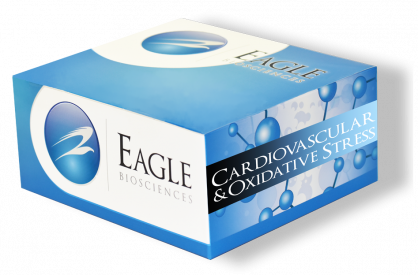Plasma Renin Activity ELISA Assay Kit
The Plasma Renin Activity ELISA Assay Kit is For Research Use Only
Size: 2×96 wells
Sensitivity: 0.14 ng/mL of Angiotensin-I
Dynamic Range: 0.2–60 ng/mL (Angiotensin-I)
Incubation Time: 105 minutes
Sample Type: Plasma
Sample Size: 500 µL
Controls Included
Assay Principle
This Plasma Renin Activity ELISA measures PRA and the results are expressed in terms of mass of angiotensin-I (Ang-I) generated per volume of human plasma in unit time (ng/mL.h). The blood sample is collected in a tube that contains EDTA. The plasma is separated and either stored frozen or kept at room temperature for immediate use, samples should not be chilled on ice or stored at temperatures between 0 and 10°C during collection or processing before adjustment of pH, this could lead to overestimation of renin activity. Before the start of immunoassay a protease inhibitor and the Generation buffer is added to the plasma sample, which will prevent Angiotensin-I (Ang-I) in plasma from degradation. The pH of the plasma sample should be around 6.0 after the addition of the supplied Generation buffer. The plasma sample is split in two and the fractions are incubated at 0–4°C (in ice bath) and 37°C respectively for 90 minutes or longer, to allow the generation of Ang-I by plasma renin at 37°C. Optionally, the pH can be adjusted to 6.5 or 7.4. Adjustment of pH is a critical step during the assay, acidification of plasma to pH 3.3 or lower for prolonged time with subsequent return to neutral pH causes irreversible activation of the renin (Derkx et al., 1987), on the other side incubation at pH higher than 8.0 can destroy renin. During the immunoassay incubation, another set of protease inhibitors are involved, which function to stop the new generation as well as degradation of Ang-I to smaller peptides. The immunoassay of Ang-I is a competitive assay that uses two incubations, with a total assay incubation time of less than two hours. During the first incubation unlabelled Ang-I (present in the standards, controls and plasma samples) competes with biotinylated Ang-I to bind to the anti-Ang-I antibody. In the second incubation the labelled Streptavidin-HRP conjugate, binds to the immobilized Ang-I-Biotin. The washing and decanting procedures remove unbound materials. The colorimetric TMB substrate is added and, after stopping the color development reaction, the light absorbance (OD) is measured in a microplate reader. The absorbance values are inversely proportional to the concentration of Ang-I in the sample. A set of calibrators is used to plot a standard curve from which the concentrations of Ang-I in the samples and controls can be directly read.
Related Products
Plasma Renin Activity LIA Assay
SHBG ELISA
Thyroid Stimulating Hormone (TSH) ELISA Assay



